The marriage of watercraft and angling have been hand in hand since, well, the invention of boats. Sport fishing has come a long way though, and the days of holding a rod in your mouth while back paddling away from the mangroves is all but forgotten in the wake of pedal drives, flush-mounted rod holders and accessory tracks found on today’s best fishing kayaks.
Whether you fish competitively or just for fun, there’s a modern fishing kayak to suit your needs and appetite. From affordable, easy-to-use recreational kayaks with just enough fish-focused features, to elaborate rigs costing thousands of dollars and capable of landing massive offshore trophies.
Fishing kayaks are also available in a range of propulsion options. Some are paddled the old-fashioned way. Others employ a fin or propeller system that’s powered by foot pedal drive. In recent years fishing kayaks have also come to accept electric trolling motors, for fully motorized kayaking.
The number of brands and models of fishing kayaks to choose from can be intimidating. Our goal is to get you on the water so you can start doing what you love: catching fish. This article will share everything you need to know to compare the best fishing kayaks and find the one that will make your kayak angling dreams a reality.
Top picks: Best fishing kayaks for 2024
The following fishing kayaks have received the highest star ratings by reviewers in our Paddling Buyer’s Guide. See and review all fishing kayaks here.
Best Fishing Kayaks

Mirage Outback
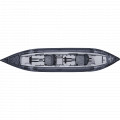
Blackfoot Angler 160
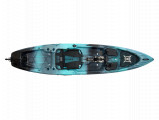
Pescador Pilot 12.0
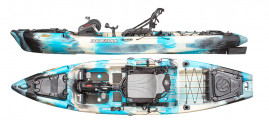
Coosa FD
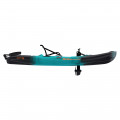
Sportsman Salty PDL 120
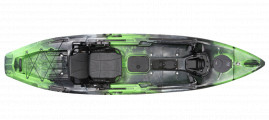
Radar 115 Fishing Kayak
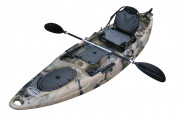
BKC RA220 Sit On Top Angler Kayak
Shop best fishing kayaks
The Paddling Buyer’s Guide is your complete resource to every fishing kayak available on the market. In the buyer’s guide you’ll find complete specifications, reviews, prices and where to buy each kayak model. To streamline your search, we’ve included the links below to filter the buyer’s guide by popular categories including type, brand, size, number of paddlers, price and top retailers.
Shop by type
Sit-on-top fishing kayaks
Sit-in fishing kayaks
Fishing kayaks with motors
Inflatable fishing kayaks
Hard shell fishing kayaks
Saltwater fishing kayaks
Ocean fishing kayaks
Folding kayaks for fishing
Inshore fishing kayaks
Kayaks for marsh fishing
Recreational fishing kayaks
Shop by number of paddlers
Shop by brand (A–J)
Advanced Elements fishing kayaks
AIRE fishing kayaks
Ascend fishing kayaks
Aquaglide fishing kayaks
Bonafide fishing kayaks
BKC fishing kayaks
Eddyline fishing kayaks
Feelfree fishing kayaks
Hobie fishing kayaks
Intex fishing kayaks
Jackson fishing kayaks
Jonny Boats fishing kayaks
Shop by brand (K–Z)
Lifetime fishing kayaks
Native fishing kayaks
NuCanoe fishing kayaks
Ocean fishing kayaks
Old Town fishing kayaks
Otto Vallinga fishing kayaks
Pelican fishing kayaks
Perception fishing kayaks
PIKE fishing kayaks
Sea Eagle fishing kayaks
Sevylor fishing kayaks
SKANU fishing kayaks
Sun Dolphin fishing kayaks
Uncharted Watercraft fishing kayaks
Vibe fishing kayaks
Wilderness Systems fishing kayaks
Shop by store
Shop by material
Shop by paddler
Shop by size
Shop by price
Shop by weight capacity
Best fishing kayaks
Want to take a deep dive into a specific type of fishing kayak and learn which are the best of their breed? The links below will take you to in-depth articles exploring more specific types and brands of fishing kayaks. Each article contains buying advice and a roundup of top models.
Best fishing kayaks by type
- Best Beginner Fishing Kayaks For 2024
- Best 12-Foot Fishing Kayaks For 2024
- Best 10-Foot Fishing Kayaks For 2024
- Best Fishing Kayaks With Trolling Motors For 2024
- Best Fishing Kayaks With Pedals For 2024
- Best Tandem Fishing Kayaks For 2024
- Best Fishing Kayaks With Motors For 2024
Best fishing kayaks by brand
- Best Lifetime Sit-On-Top Kayaks For 2024
- Best Pelican Sit-In Kayaks For 2024
- Best Jackson Kayaks For 2024
- Best Hobie Tandem Kayaks For 2024
- Best Ocean Kayaks For 2024
- Best Hobie Inflatable Kayaks For 2024
- Best Hobie Pedal Kayaks For 2024
- Best Advanced Elements Kayaks For 2024
- Best Hobie Sailing Kayaks For 2024
- Best Aquaglide Kayaks For 2024
Shopping for a used fishing kayak?
Buying a fishing kayak can be a big investment. You’ve probably peeked at a few price tags and asked yourself how a fishing kayak could cost more than your first car. A great way to find a deal on a quality fishing kayak is to purchase used. But before jumping into the rabbit hole and searching “Craigslist fishing kayak” or “fishing kayak Kijiji”, you need to know what to look for.
Here are a few things to keep in mind when buying a used fishing kayak.
Know what you are looking at and what you want
Classified ads can use terms like fishing kayak broadly. The ad should have plenty of photos of the kayak, as well as details. If not, get more photos and details.
Be sure you have the brand, model and any other specifics like length to help you research a specific used kayak. If you are uncertain, ask the seller questions about how and where they used the kayak.
When deciding what kind of fishing kayak you need, use the buying guide section of this article as a reference.
Does the price of a used kayak make sense compared to buying new?
Depending on which brand of fishing kayak you find there can be a wide price range for the sticker price of a new boat. Do your brand research and see how much of a deal you are actually getting for the pre-loved boat.
If you are scooping up an expensive kayak for under $1,000, that’s great. But if you are looking at models which only cost a few hundred dollars when bought new, consider if the beat-up boat that’s growing mold under the seller’s porch is actually a better deal than a new purchase.
Be skeptical of owner-installed modifications
Souping up your rig is a common kayak angler pastime. The idea of going overboard doesn’t really exist for kayak anglers, at least not when it comes to adding additional gear mounts or installing a trolling motor mount via two-by-fours.
Making modifications to your fishing kayak is fun but, when purchasing a used fishing kayak, be skeptical of the work others have done to the kayak. Look for cracks and gaps around any bolts and holes which have been added. These will leak, and be points of failure on a kayak. Self-made modifications aren’t exactly manufacturer approved, so unless you’ve found the dream rig you could never put together on your own, it’s better to have a kayak on which you can make your own modifications.
Will this kayak actually work for your needs?
There are a lot of fishing kayak models on the market. Some are good, and some are terrible. You want to know a kayak has the speed, tracking, performance and (perhaps most of all) stability you will be comfortable with. The only way to know for sure if a fishing kayak is the best for you is to get it out on the water. See if you can meet the seller near a launch site, or make other arrangements for test paddling before committing to a purchase. Have your PFD, paddle and paddling layers with you unless these items are part of the sale.
For more tips on what to look for when selecting a used fishing kayak, read our How To Buy A Used Fishing Kayak.
Fishing kayak buying guide
Buying your first fishing kayak can be a really exciting time, but with so many options and different designs out there, figuring out how to choose a fishing kayak can also be really confusing. We’ve created this all-inclusive, definitive guide to answer your questions and make buying a fishing kayak a smooth and fun process.
Once you know what to look for in a boat, take a look at our Paddling Buyer’s Guide and shop for your perfect boat before you even leave your house. Then, compare, test and buy with ease!
Where will you be fishing?
The first question when choosing a fishing kayak is always, “where are you going to be fishing most of the time?” Specifically, what type of water will you be paddling in? If you’re going to be trolling for big lake trout for 90 percent of your fishing, you probably don’t need a super stable (and slower) kayak designed for standup fishing.
Are you going to be fishing faster moving water in rivers and creeks? Are you going to encounter rapids? If so, you’ll want a shorter, more nimble fishing kayak, usually less than 12 feet. Most moving water anglers will also want to avoid pedal drives that can be damaged on underwater rocks.
Are you going to be fishing bigger lakes, ponds or inshore? You’ll want a kayak which can get up and move, somewhere between 12 and 16 feet long.
Open ocean? You’ll want the longest and skinniest boat you can paddle comfortably so you can get out far with ease. Boats longer than 16 feet are going to be best for your type of kayak fishing. Secondary stability (how stable the kayak feels when tilted to the side) will be an important factor for an open ocean fishing kayak.
What’s your experience level in a kayak or canoe?
This question is more about balance than anything. Your experience level helps determine how skinny a boat can be before you feel unstable. Brand new paddler anglers are going to want a boat that is wider, at least 32” wide, so they don’t feel like they’re about to tip over with every cast. A more experienced angler who’s used to feeling a nimble craft rocking beneath them will be able to upgrade to a more nimble boat, something skinnier than 32”, which will make paddling around more enjoyable.
How does the kayak fit?
Turns out one size does not fit all. A larger angler may feel more comfortable in a wider kayak while a shorter angler looks for a narrow boat. Smaller, lighter paddlers may prefer to paddle while larger, heavier anglers go farther with less effort by using pedals or a motor.
Fit comes down to more than length and width of the kayak. The kayak’s seat is the first thing to test. Not only should the seat be padded, fast drying and adjustable, but it must provide a solid platform for paddling or pedaling. Matching the angler’s body size to the seat size ensures the kayak fits like a glove.
Paddle, pedal or motor
Traditional paddle kayaks get where they are going the old-fashioned way. Paddle kayaks are lighter and cheaper than pedal- or motor-equipped alternatives. Aside from weight and cost, paddle power is better suited to some environments. If you’re going to be fishing swift moving rivers where you need to be agile and shallow, rocky bottoms come up fast, then a paddle kayak makes great sense.
One of the downsides to a paddle-only kayak is the need to use your hands for multiple tasks while fishing. It can quickly get frustrating to try to multitask with your hands. Both pedal- and motor-powered kayaks give anglers a hands-free option. This is a great advantage if your main focus is fishing, you have the room in your budget and you don’t mind hauling the additional weight of a pedal drive or trolling motor.
Both pedal and power options keep you on the water longer through the use of leg muscles or a marine battery. Most fishing kayak manufacturers now offer pedal-drive models, and many companies are now offering kayaks with motors or motor kits.
Pedal power keeps the experience simpler and human-propelled (and so remains a great way to exercise), and requires less overhead and maintenance than a trolling motor. If you want the stealth of a kayak, but the range and ease of a big motorboat, then check out boats with a motor option.
Sit-on-top vs sit-inside
Whether an angler should get a sit-inside or a sit-on-top kayak is really a mix of personal preference and the style of fishing you’ll be doing.
A sit-on-top fishing kayak is the most popular for kayak angling. A sit-on-top kayak is like having an open workbench. Almost everything, including the seating area, is laid out on the deck of the kayak. The seat being on top of the flat deck is the main feature of a sit-on-top kayak. This gives the paddler access to much of the kayak deck space while underway. You can reach a tackle box, swing a leg over the side to land your fish and, on models with sufficient stability, you may even stand up to cast or gain a better view.
Sit-inside kayaks are another type of fishing kayak, and are a bit of an old-school choice. With a sit-inside kayak the paddler sits within the interior of the kayak. It’s a nice way to stay out of the elements, but decreases mobility for an angler. Sit-inside kayaks usually have hatches to store gear internally, this can be helpful if you are spending more time paddling than going through your lures, but also limits access to your tackle.
One of the biggest downsides to a sit-inside kayak is in the consequences of a capsize. When a sit-inside kayak capsizes the open cavity of the kayak fills with water. This means you have to get to shore and empty the kayak before you can re-enter. With a sit-on-top kayak, if you fall over or the kayak capsizes, you can just climb back on. If you’re going to be fishing out in the ocean or on a big lake where there’s a chance you could flip and have to get back in quickly and easily, a sit-on-top is the best option.
Hull design
The hull design will tell you a lot about how the kayak will perform on the water.
If the kayak has a pronounced keel running down the center then the boat is designed to track nicely in a perfect straight line. If the bottom of the hull is smooth with no keel protruding then the boat will be more agile and turn on a dime, but also harder to stand in. Pontoon hulls have a W-shape and are some of the most stable overall, though they generally plow slowly through the water. Pontoon shapes provide a great hull shape for a wide kayak with a standing platform within the cockpit.
When considering hull design the most important factor for kayak anglers is usually stability.
There are two types of fishing kayak stability. Primary and secondary. Primary stability is the amount of effort it takes to tilt the boat onto its edge, or in other words, to engage the secondary stability. Once on its edge, secondary stability is the amount of effort it takes to actually flip the boat over.
The easiest way to think about the two types of stability is to look at a jon boat compared to a sea kayak. Jon boats have flat bottoms with tons of primary stability, but the straight sides have very little secondary stability. It’s very hard to get a jon boat on its side, but once it is on its side, since there’s no secondary stability, the boat just flips right over. A sea kayak on the other hand has little primary stability, meaning it can tip over onto its edge pretty easily, but then it has more secondary stability so paddlers can carve on their edge or recover.
As a guideline, when it comes to width, the wider the fishing kayak the more stable it’ll be and better for standing. If you need a kayak to stand up and cast or sight fish from all day, then look toward wider fishing kayaks. Of course there are other factors to consider in hull shape, but as a general principle, the concept of more width equals more stability holds true.
A final consideration is length. In general, length equals speed—if everything on two different boats was exactly the same, the longer boat would be faster. If you need a boat that can go the distance or battle big tides, a faster boat might be the better option for you. Shorter boats tend to be more agile, so if you’re fishing moving water where dodging rocks is a factor, then you might want a shorter, stubbier boat that can turn on a dime.
Hull materials
Rotomolded plastic
The vast majority of fishing kayaks you’ll come across on your shopping quest will be made from rotomolded polyethylene. Most kayaks are rotomolded polyethylene because it is easy to produce and durable. You can slam up against rocks, structures, trees, the beach, and these things will keep on truckin’. The hull of a rotomolded kayak is produced as one piece with a rotational mold in an industrial-size oven.
Thermoformed plastic
Some companies have started making fishing kayaks from thermoformed plastic. Thermoformed plastic kayaks are often lighter than rotomolded kayaks. A thermoformed kayak can be made of various types of plastic, though polyethylene and ABS are popular. Thermoformed kayaks are produced in a top and bottom half and joined with a seam around the waterline.
Composites
Fishing kayaks made of composite materials such as carbon fiber are starting to pick up traction. The materials are expensive, but the performance and weight can be unmatchable. Composites such as carbon or fiberglass are mixed with resin and laid in layers. Composite kayaks can be cracked, but they can also be repaired. These can be some of the highest cost kayaks you’ll come across.
Inflatables
Inflatable kayaks can be a great option for anglers who don’t want to car-top or trailer their boats, or don’t have the storage space for a 12-foot rigid kayak. Inflatables can be made of various materials, but PVC or polyurethane-coated fabrics are most common. Simple inflatables are among the cheapest fishing kayaks available, but are also slower and have fewer fishing features.
Fishability features
Accessories like gear tracks, rod holders, livewells, tackle storage, camera and video mounts, light mounts and deck padding can all add to a boat’s fishability and make it a real fishing-ready craft.
Some boats come fully rigged with all the gadgets you might want, so you’re ready to fish the moment you buy your boat. One way beginner boats cut cost is with fewer rod holders, gear tracks and hatches. For beginners, accessories are less important—you can always add gadgets and gear down the road.
A final word of advice
Try out as many different boats as you can before you buy. Your local paddling shop is also a great place to ask questions and seek demos of various models. While you are there check out accessories like paddles and PFDs designed for use with fishing kayaks.
There is still a lot of water to cover when it comes to discussing the best fishing kayaks. Here are answers to some of the top questions kayak anglers have.
-
Are kayaks good for fishing?
Kayaks make a great watercraft for fishing, especially those specifically designed for kayak angling. A kayak is easy to transport, less paperwork and upkeep than a motorized boat, and generally more affordable to purchase. The best part of fishing from a kayak though may be the ability to reach places a motorized boat can not, and taking part in a physically engaging and environmentally friendly activity while fishing.
-
Is a fishing kayak worth it?
You do not need to purchase a kayak specifically designed for fishing in order to fish from a kayak. However, if your main aim for heading out on the water is fishing, then a kayak designed specifically for angling can make the experience much more enjoyable. Fishing kayaks include features such as rod holders, gear mounts and tank wells to store your rods, tackle and bait. Higher end fishing kayaks may even have pedal drives or electric trolling motors to keep your hands free for more fishing action.
-
Can you fish from a kayak?
You can absolutely fish from a kayak. Choose a kayak equipped with rod holders and other fishing-focused features for the easiest kayak angling experience. Some fishing kayaks are even designed with enough width and stability to use as a standing platform for casting.
-
Should I buy a fishing kayak?
Whether you buy a fishing kayak or another type of kayak is largely dependent on your primary use for the kayak and the types of waterways you’ll be paddling. If you expect to use the boat primarily for fishing outings, then a fishing kayak is the best choice, as these types of kayaks include rod holders and storage areas for tackle.
Fishing kayaks are also designed with stability in mind for casting and fighting fish. If you plan to paddle more recreationally with some casual fishing on the side, then a lighter weight and cheaper recreational kayak may be more appropriate for your needs.
-
Kayak vs fishing kayak
Fishing kayaks share many of the same design elements as most other kayaks. Some of the most affordable fishing kayaks are simply recreational kayak designs with a few additional features specific to fishing, such as rod holders, gear mounts and tackle or bait storage areas.
Higher priced fishing kayaks include deck and hull shapes specifically designed around kayak fishing, including pontoon hulls for standup stability and pedal drive or electric motors for greater range and speed. These fishing kayaks are also considerably more expensive than a basic kayak.
-
Fishing kayak vs touring kayak
Kayaks labeled as fishing kayaks have different dimensions and features than those labeled as touring kayaks. A fishing kayak is usually wider and much more stable than a touring kayak.
Touring kayaks are generally longer and narrower, and have more speed to cover distance on a paddling focused outing, while fishing kayaks are usually designed more for comfort and stability over speed.
A fishing kayak also includes fishing specific features such as rod holders, accessory tracks and tankwells for on deck storage. By comparison, a touring kayak will have a more streamlined deck profile, and most storage will be within the kayak and accessed through hatches on the deck.
-
Fishing kayak vs jon boat
A fishing kayak differs from a Jon boat in design and usually propulsion. A Jon boat is a lightweight, flat bottomed boat powered by a small motor. While some kayaks have started to include electric trolling motors, fishing kayaks are generally powered by human effort with a paddle or foot pedal drive.
Another difference between using a fishing kayak versus a Jon boat is paperwork. Since a Jon boat is a motorized vessel, it will require registration in more jurisdictions than a kayak.
-
Fishing paddleboard vs kayak
A fishing paddleboard refers to a standup paddleboard rigged for fishing. A standup paddleboard has a flat open deck, and is paddled from a standing position with a long, single-blade paddle.
Fishing from a standup paddleboard has benefits such as an increased line of sight and superior stealth. Plus, you can attach gear to just about anywhere on the deck. Some hybrid paddleboards even have a removable seat so you can sit to rest or fight fish.
On the other hand, fishing from a kayak provides more capability and stability in rough water conditions, and a kayak also has more storage space.
-
Fishing boat vs kayak
A fishing boat usually refers to a motorized vessel. Fishing kayaks have the advantage of being lighter, and capable of reaching shallower and tighter waterways. Fishing kayaks generally have less overhead cost as well, are easier to maintain, store and transport, and provide a physically active and environmentally friendly fishing experience.
-
Fishing kayak vs recreational kayak
Fishing kayaks and recreational kayaks are often quite similar in design. However, fishing kayaks have more features for dedicated kayak anglers, including rod holders, gear tracks and tackle storage areas. Choose a fishing kayak if fishing will be your primary on-water focus; a recreational kayak is a solid choice for paddlers who may want to occasionally toss a line.
-
Fishing kayak vs regular kayak
Fishing kayaks have a general resemblance to other types of kayaks, especially recreational kayaks. Recreational kayaks are intended for use on calm, sheltered water and slow moving waterways. Recreational kayaks generally prioritize stability over speed.
Fishing kayaks tend to have similar overall performance to recreational kayaks, however they will also include fish-focused features such as rod holders or larger tankwells for storage.
Fishing kayaks may also have specific design elements such as a pontoon hull for increased stability, or a flat open area in the cockpit to provide a platform for standing, which you would not find on a regular recreational kayak.
-
What makes a good fishing kayak?
A good fishing kayak should have a comfortable seat for spending extended time sitting while you are on the water. A fishing kayak should also feel stable enough for you to cast, fight and land fish. Good fishing kayaks have a thoughtful layout of storage space for your tackle, rods, paddle and other accessories.
-
Sit in or sit on kayak for fishing
Both sit-inside and sit-on-top kayaks are capable of fishing, but the vast majority of dedicated fishing kayaks are of a sit-on-top design. The reason for this is simple: sit-on-tops tend to be wider and more stable, with open decks that allow better paddler mobility and access to gear. A sit-inside will also fill with water should you capsize, while a sit-on-top will not, and can easily be re-entered if the paddler falls off or tips over in deep water.
-
What size fishing kayak do I need?
The size of the fishing kayak you need is dependent on how and where you plan to use your fishing kayak. A 12-foot kayak is a great starting length for a good all-around fishing kayak. Choose a longer kayak if your ambitions run to covering more ground on open bays and larger lakes.
-
Fishing kayak features
Some of the most common fishing kayak features include flush-mount and swiveling rod holders, gear tracks for mounting fish finders and other accessories, open tankwells for tackle storage, small hatches for dry storage, a paddle holder and an elevated folding seat.
-
How much does a fishing kayak weigh?
The weight of a fishing kayak is dependent on its construction, size and design. It’s common for simple, paddle-powered fishing kayaks to weigh over 50 pounds. Pedal-powered fishing kayaks, with their complex pedal drive and elevated lawn-chair seat, can weigh well over 100 pounds.
In general, fishing kayaks are often heavy and cumbersome to lift and transport. For this reason, kayak anglers typically use a cart to wheel their kayak to and from the water.
-
Fishing kayak width
Fishing kayak width will vary with each fishing kayak model. Many fishing kayak designs will commonly be wider than other types of kayaks to provide more stability for casting and fighting fish, and even standing on the kayak. For a beginner-friendly fishing kayak, look for widths greater than 32 inches.
-
Best length for fishing kayak
The best length for a fishing kayak largely depends on how and where you plan to use your kayak. The 10- to 12-foot range is the most common length of fishing kayak. This size provides a good overall length for a variety of waters, with a user-friendly blend of speed, maneuverability, and ease of storage and transportation.
If you’ll mostly be fishing bigger lakes, ponds or inshore, you will want a kayak that is faster for covering distance, somewhere between 12 and 16 feet long.
-
Fishing kayak weight capacity
A fishing kayak’s weight capacity will vary with each kayak model. Be sure to check the manufacturer’s specifications to ensure the combined weight of you and your gear is within the kayak’s maximum weight limit. In general, fishing kayaks have higher weight capacities than similarly sized recreational kayaks.
-
How much do fishing kayaks cost?
Entry level kayak anglers looking to purchase a new fishing kayak should expect to spend around $1,000 for a paddle-powered kayak, and about $2,000 for a pedal-drive fishing kayak. The top fishing kayak models can cost $4,000 or more.
-
Why are fishing kayaks so expensive?
The price of a fishing kayak will likely be higher than a similar recreational kayak because of the inclusion of specialized outfitting accessories for kayak anglers. The price is also higher because many fishing kayaks are larger than recreational kayaks, requiring the use of more materials in production. Advanced features like pedal drives or e-motors also drive the price of these fishing kayaks much higher than paddle-powered models.
-
Do fishing kayaks flip easily?
Fishing kayaks are generally very stable, and most of the popular designs do not flip easily. Paddlers should understand there is always a possibility of capsizing. Dress appropriately, wear a properly fitting PFD (personal flotation device), and check the kayak’s maximum capacity before use.
-
Fishing kayak speed
The speed of a fishing kayak is relative to its length and shape, as well as a paddler’s ability. All other things being equal, longer equals faster. A fishing kayak with a long, narrow waterline is capable of more speed than a short, wide kayak.
Expect most paddle-powered fishing kayaks in the 10- to 12-foot range to have an average speed of around 2 mph, and be able to pick up to a higher speed of around 3 mph.
Pedal drive kayaks will have a similar average speed as a paddle kayak, but can reach top speeds of around 5 mph.
Finally, motorized fishing kayaks, such as Old Town kayaks with Minn Kota trolling motor, can travel at sustained speeds over 4 mph.
-
Are fishing kayaks safe?
Like any other kayak, the safety of fishing kayaks relies on the proper use of personal safety equipment, good judgment and an understanding of appropriate waterways for your ability level and the kayak you are using.
Keep in mind there is always the possibility of a kayak capsizing. Practicing how to self-rescue is an important skill.
For an inexperienced paddler, a sit-on top fishing kayak is a safer choice than a sit-inside design. Unlike sit-in kayaks, which will flood with water if they tip over, a sit-on-top kayak doesn’t take on water and won’t sink if capsized.
-
Are fishing kayaks stable?
Fishing kayaks are some of the most stable in the kayak market. In fact, some fishing kayaks are stable enough to allow comfortable standup fishing. Look for a fishing kayak with a pontoon hull for maximum stability.
Paddlers should understand there is always a possibility of capsizing. Dress appropriately, wear a properly fitting PFD (personal flotation device), and check the kayak’s maximum capacity before use.
-
Where to buy a fishing kayak
Fishing kayaks are widely available across North America at many big-box outdoor, hardware and department stores, as well as through online retailers like Amazon. The best place to purchase a fishing kayak, though, is your nearest paddling specialty shop. Paddling specialty shops have a vast understanding of kayaks and your surrounding waterways, and can provide you with proven advice for purchasing the best fishing kayak for your needs.
-
Can you tour in a fishing kayak?
While you can certainly tour shorter distances in a fishing kayak, this is not the most efficient craft for covering many miles. Fishing kayaks have less hull speed and glide than dedicated touring kayaks, as well as less interior storage space. However, if you pack thoughtfully and plan a bit more time, a fishing kayak—especially longer models (14 to 16 feet) designed for offshore fishing—can be used for ambitious day tours or even a multi day excursion.
-
Can you use a fishing kayak on the river?
There are fishing kayak models designed with rivers in mind. Some will even handle mild rapids as well. A fishing kayak intended for the river will be shorter with a smooth, flatter bottom for better maneuverability.
-
Most stable fishing kayak
It’s difficult to say which fishing kayak model is the most stable, however, in general wider fishing kayaks with a pontoon hull provide more stability and a better platform for standing.
-
Fastest fishing kayak
As a general rule, longer, narrower and lighter fishing kayaks are the fastest. Take this into account when assessing the top speed of different fishing kayaks.
Expect the fastest paddle-powered fishing kayaks to top out around 3 mph, with motorized and pedal drive kayaks reaching a max speed of about 5 mph.
Fishing kayak reviews
How does a specific fishing kayak model perform on the water? What’s the story with the brand? What are popular modifications for a fishing kayak? Our comprehensive reviews discuss on-water performance, company background, design and popular modifications, as well as specifications, price and places to purchase.
- Kayak Review: Sun Dolphin Excursion 10
- Recreational Kayak Review: Wilderness Systems Tarpon 100
- Fishing Kayak Review: SeaStream Angler 120 PD
- Recreational Kayak Review: Ocean Kayak Frenzy
- Inflatable Recreational Kayak Review: Intex Challenger K1
- Fishing Kayak Review: Ascend FS10
- Fishing Kayak Review: Sun Dolphin Journey 10
- Fishing Kayak Review: Ascend 12t
- Recreational Kayak Review: Pelican Trailblazer 100 NXT
- Fishing Kayak Review: Sun Dolphin Boss 12 SS




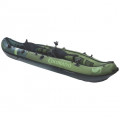

-first_product_boats.jpg)

